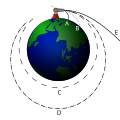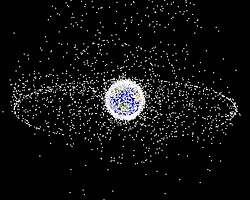Outer space


Outer space, commonly shortened to space, is the near-vacuum between celestial bodies.[1] It is where all of the planets, stars, galaxies and objects are found. It is the expanse that exists beyond Earth and its atmosphere.
On Earth, space begins at the Kármán line (100 km above sea level).[2] This is where Earth's atmosphere is said to stop and outer space begins. This is not a natural boundary but is a convention used by scientists and diplomats.
List of spaces
Geospace
Geospace is the region of outer space near Earth. It includes the upper region of the atmosphere and the magnetosphere.[3] The Van Allen radiation belt lies within the geospace.
The space inside the magnetosphere is protected from radiation from the Sun, our closest star. It has a low level of electrically charged particles.
Interplanetary space
Interplanetary space is the space around the Sun and planets of the Solar System. It has the solar wind, a continuous stream of charged particles from the Sun. This stream creates a very thin atmosphere (the Heliosphere) for billions of miles or kilometers into space.
Interplanetary space has the magnetic field generated by the Sun.[4] Planets such as Jupiter, Saturn, Mercury and the Earth also have Magnetospheres. These magnetic fields can trap particles from the solar wind and other sources, creating belts of magnetic particles such as the Van Allen radiation belt. The solar wind gradually strips off the atmospheres of planets without magnetic fields, like Mars.[5]
Interstellar space
Interstellar space is the physical space in a galaxy that is not occupied by stars or their planetary systems. It continues to the edges of the galaxy, where it fades into the intergalactic void.
Most of the mass in this space is made up of single hydrogen atoms, fewer helium atoms and a few heavier atoms formed in stars. Supernovae blow some of their atoms huge distances.
A number of molecules and tiny 0.1 μm dust particles do exist in interstellar space.[6] About four new types of molecules are discovered each year. Large regions of higher-density matter known as molecular clouds allow chemical reactions to occur. This includes organic polyatomic species. Much of this chemistry is driven by collisions.
Intergalactic space
Intergalactic space does have 'cosmic voids' between the large-scale structures of the universe.
Exploration
Exploring space by direct travel is difficult, and more or less impossible beyond the near planets.
Space contains no air beyond the Earth. Manned spacecraft are designed to keep air inside them and to protect astronauts from extreme temperatures.
It takes three days of travelling to reach the Moon and, depending on speed, it would take a very long time to reach the closest star (Proxima Centauri). Radiation also endangers human life. Many people are skeptical that humans will ever travel beyond the near planets.
Telescopes
We gain most of our information about the items in space from different kinds of telescopes. Some of them are space telescopes, put in outer space for a better view. Space probes also explore planets, comets and other space objects that are not too distant.
Outer Space Media
Timeline of the expansion of the universe, where space is represented schematically at each time by circular sections. On the left, the dramatic expansion of inflation; at the center, the expansion accelerates (artist's concept; neither time nor size are to scale)
A wide field view of outer space as seen from Earth's surface at night. The interplanetary dust cloud is visible as the horizontal band of zodiacal light, including the false dawn (edges) and gegenschein (center), which is visually crossed by the Milky Way
Because of the hazards of a vacuum, astronauts must wear a pressurized space suit while outside their spacecraft.
Conventional anti-satellite weapons such as the SM-3 missile remain legal under the law of armed conflict, even though they create hazardous space debris
Newton's cannonball, an illustration of how objects can "fall" in a curve around the planet
Earth and the Moon as seen from cislunar space on the 2022 Artemis 1 mission
Related pages
References
- ↑ Daintith, John; Gould, William (2012) [2006]. Collins Dictionary of Astronomy (Fifth ed.). HarperCollins. p. 414. ISBN 9780007918485.
- ↑ "Where does space start?", All About Space, Imagine Publishing, no. 1, p. 84, 2012-06-28
- ↑ Schrijver, Carolus J. & Siscoe, George L. 2010. Heliophysics: evolving solar activity and the climates of Space and Earth. Cambridge University Press, p363. ISBN 0-521-11294-X
- ↑ Papagiannis, Michael D. 1972. Space physics and space astronomy. Taylor & Francis, 12–149. ISBN 0-677-04000-8
- ↑ Johnson R.E. 1994. Plasma-induced sputtering of an atmosphere. Space Science Reviews 69 (3–4): 215–253. [1]
- ↑ Rauchfuss, Horst 2008. Chemical evolution and the origin of life. transl. T.N. Mitchell. Springer, p101. ISBN 3-540-78822-0







